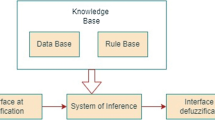Abstract
Effective quality of service (QoS) management is essential to the smooth running of wireless networks and to guarantee peak performance. This study suggests a unique method for enhancing QoS in wireless networks that combines fuzzy logic with iterative weighted least squares (IWLS). Performance of the system is anticipated to be improved by dynamically modifying system settings depending on network input. When handling the uncertainties and imprecisions present in wireless contexts, fuzzy logic is used, allowing for adaptive decision-making depending on the state of the network. By adding network input, IWLS is also used to repeatedly adjust system parameters. To further improve QoS performance, an adaptive neural fuzzy iterative weighted least squares (ANFIWLS) method is presented. Fuzzy logic, neural networks, and IWLS work together to provide more precise inference and decision-making skills. According to a comparison, ANFIWLS beats fuzzy logic alone, resulting in a QoS increase of around 32.8%. This gain is most noticeable in settings with moderate loss rate, low jitter, medium latency, and high throughput. Fuzzy logic is used with ANFIWLS and IWLS to allow for the adaptive modification of QoS parameters in wireless networks, improving user experience and system performance as a whole. The results of this research aid in the creation of QoS management systems for wireless communication networks that are more dependable and efficient.






Similar content being viewed by others
Data Availability
No new data were generated for this project.
References
Abrahão, D.C., Vieira, F.H.T.: Resource allocation algorithm for LTE networks using fuzzy based adaptive priority and effective bandwidth estimation. Wirel. Netw. 24, 423–437 (2018)
Addison, P.S.: The Illustrated Wavelet Transform Handbook: Introductory Theory and Applications in Science, Engineering, Medicine, and Finance. CRC press, Boca Raton (2017)
Borjigin, S., Sahoo, P.K.: Color image segmentation based on multi-level tsallis-havrda-charvát entropy and 2d histogram using pso algorithms. Pattern Recogn. 92, 107–118 (2019)
Chen, Y., Li, L., Peng, H., Xiao, J., Wu, Q.: Dynamic multi-swarm differential learning particle swarm optimizer. Swarm Evol. Comput. 39, 209–221 (2018)
Dalgic, I., Tobagi, F.: Glitches as a measure of video quality degradation caused by packet loss. Technical Report No. CSL-TR-96–702, Computer Systems Laboratory, Department of Electrical Engineering and Computer Science, Stanford University, Stanford, USA (1996)
Fu, B., Staehle, D., Kunzmann, G., Steinbach, E., Kellerer, W.: QoE-based SVC layer dropping in LTE networks using content-aware layer priorities. ACM Trans. Multimed Comput. Commun. Appl. (TOMM). 12, 23 (2015)
Gannoune, L., Robert, S.: Dynamic tuning of the contention window minimum (CWmin) for enhanced service differentiation in IEEE 802.11 wireless adhoc networks. IEEE Int. Sympos Personal Indoor Mobile Radio Commun. (PIMRC’04). 1, 311–317 (2004). rence on Advances in Cybernetics Systems, United Kingdom, Chap. 5
Khan, N., Nasralla, M.M., Martini, M.: Network and User Centric Performance Analysis of Scheduling Strategies for Video Streaming over LTE. In Proceedings of the IEEE International Conference on Communications (ICC)—Workshop on Quality of Experience-based Management for Future Internet Applications and Services (QoE-FI), London, UK, 8–12 June (2015)
Khokhar, S., Zin, A.A.B.M., Mokhtar, A.S.B., Pesaran, M.: A comprehensive overview on signal processing and artificial intelligence techniques applications in classification of power quality disturbances. Renew. Sustain. Energy Rev. 51, 1650–1663 (2015)
Ray, P.K., Mohanty, S.R., Kishor, N.: Classification of power quality disturbances due to environmental characteristics in distributed generation system. IEEE Trans. Sustainable Energy. 4(2), 302–313 (2013)
Rehman, I.U., Nasralla, M.M., Philip, N.Y.: Multilayer perceptron neural network-based QoS-aware, content-aware and device-aware QoE prediction model: A proposed prediction model for medical ultrasound streaming over small cell networks. Electronics. 8, 194 (2019)
Siahkali, H.: December. Power quality indexes for continue and discrete disturbances in a distribution area. In Power and Energy Conference, PECon 2008. IEEE 2nd International, 2008; 678–683 (2008)
Smith, J.C., Hensley, G., Ray, L.: IEEE recommended practice for monitoring electric power quality. IEEE Std ; 1159–1995. (1995)
Szmajda, M., Gorecki, K., Mroczka, J.: October. DFT algorithm analysis in low-cost power quality measurement systems based on a DSP processor. In Electrical Power Quality and Utilisation, 2007. EPQU 2007. 9th International Conference on IEEE, ; 1–6 (2007)
Funding
Not Applicable.
Author information
Authors and Affiliations
Contributions
Dr. Kapil Aggarwal: Contributed to simulations, data collection, writing the main text of the article. Dr. P. N. Renjith: investigation, visualization, writing–review & editing. Dr. P. Udayakumar: Contributed data collection, data analysis. Mr. K. Thyagarajan: Contributed to simulations, data collection, Dr. L. Sherly Puspha Annabel: Contributed to data analysis, and potentially provided input in writing the main text of the article. S. Jayachitra: methodology, software, writing–original draft.
Corresponding author
Ethics declarations
Competing interests
The authors declare no competing interests.
Conflict of interest
The authors declare that there are no conflicts of interest related to this article.
Ethical approval
The work that has been submitted for publication does not include any financial or non-financial interests, the authors would want to make that clear.
Additional information
Publisher’s Note
Springer Nature remains neutral with regard to jurisdictional claims in published maps and institutional affiliations.
Rights and permissions
Springer Nature or its licensor (e.g. a society or other partner) holds exclusive rights to this article under a publishing agreement with the author(s) or other rightsholder(s); author self-archiving of the accepted manuscript version of this article is solely governed by the terms of such publishing agreement and applicable law.
About this article
Cite this article
Aggarwal, K., Renjith, P.N., Udayakumar, P. et al. Enhancing quality of service in wireless systems using iterative weighted least squares with fuzzy logic integration algorithm. Opt Quant Electron 55, 1086 (2023). https://doi.org/10.1007/s11082-023-05295-6
Received:
Accepted:
Published:
DOI: https://doi.org/10.1007/s11082-023-05295-6




